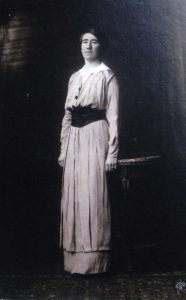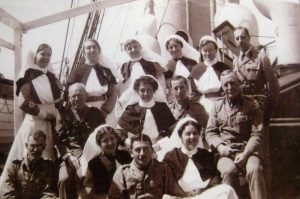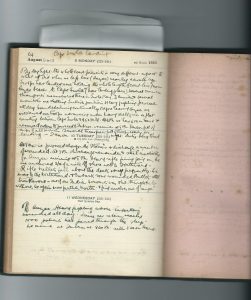< Women Away from the Western Front
‘When the Empire Calls’: the story of Nurse Muriel Leontine Wakeford
A century ago the British Empire was at its height, with colonies and dominions spread across the globe. From today’s perspective, it’s hard to imagine the feelings of loyalty and patriotism which people living in Australia, Canada, the West Indies and other parts of the Empire had for the ‘mother country’. They were British subjects and called themselves ‘British’. This story of an Australian nurse gives an insight into the way people responded ‘when the Empire called’.
The 13 year old pianist

Muriel Leontine Wakeford. © From the collections of Wollongong City Libraries and the Illawarra Historical Society (P25254)
Leontine Sara Wakeford, also known as Muriel Leontine Wakeford, was born the eldest of four children on 14 June 1887 in the Bathurst region of New South Wales. Her father, Henry George Wakeford, ran a bicycle shop and a florist shop.
Muriel played the piano. Aged thirteen, she took a principal part in her school drama evening. As if foreshadowing what was to come, her performance was entitled ‘When the Empire Calls’. (Illawarra Mercury, 18 September 1900)
She trained as a nurse and became matron at Cooma District Hospital and later at Berrima (now Bowral) District Hospital.
Off to war
At the outbreak of war, Muriel volunteered to serve in the Australian Army Nursing Service. She set off on the hospital ship, HMHS Kyarra in November 1914, arriving in Egypt the following January.
During her time as a war nurse, she kept a diary. Here is the first entry:
Wednesday 24th of November
A momentous day indeed. At 4pm we pushed off from Circular quay amidst wild enthusiasm and also a terrific storm. The ferry boats all saluted, the crowd cheered and I felt pretty miserable. My first experience at sea. The night was wild indeed – three sea men were knocked over by the elements and one had to be operated on next morning. I was fortunate enough to be able to assist at the operation. Unique experience at sea.
In early April 1915 she was sent aboard the hospital ship Sicilia bound for the island of Lemnos, thirty miles from Gallipoli and the Dardanelles Straits. She was astonished to find herself transferred to HS Gascon after a couple of weeks.
‘The boys are wonderfully plucky’

Nurses on the Gascon Hospital ship, Gallipoli. Muriel Wakeford pictured back row, second from the left. © From the collections of Wollongong City Libraries and the Illawarra Historical Society (P25255)
Less than forty eight hours later the bombardment of the Dardanelles commenced. The wounded started to come on board at 9am. They were the first of thousands of injured, dying and diseased men that Muriel and her colleagues cared for over the next few months. Muriel wrote in her diary:
Sun 25 Apr 1915
Bombardment of the Dardanelles commenced 5 am. Moved off at 1am. Reached Gaba Tepe at 5. Shells were bursting everywhere. At 9 the first lot of wounded came on board. At midday the place was a fiery inferno. The London was lying almost touching us. Shells from the enemy frequently burst quite close to us. The first landing party cut to pieces by the Turks who fired shrapnel before the lighters even touched the beach.
At 6.30 left for Lemnos with 600 on board. In the meantime the wounded had to be placed on the various transports pending arrival of another hospital ship. The boys are wonderfully plucky and everyone on our ship worked like fury – to help them.
During this time she wrote frequent letters to her parents who sent them to local newspapers. She became something of a local celebrity through their publication. Her column “A Letter from Nurse Wakeford” became an occasional feature in the Illawarra Mercury. Such was the newspaper’s interest in her that they even printed a letter she sent to her mother in 1924. Many of her letters have been indexed on Trove, an Australian digital database.
‘Wounded arriving continually’
Muriel was still serving at Gallipoli in August 1915 and wrote in her diary about the Suvla Bay landings. Suvla Bay was a new Allied landing point on the Gallipoli peninsula. The attack led to heavy casualties on both sides.
Mon 9 Aug
By daylight the whole coast presents a very different aspect to what it did when we departed here (Anzac) nearly a month ago. Troops have landed and are holding the whole length of coastline from Anzac beach to Cape Suvla (new landing place). Several cruisers and transports are anchored there in Suvla Bay. 3 cruisers and several monitors are shelling Turkish positions. Heavy fighting proceeds all day. Wounded arriving continually. Before leaving Anzac we witnessed our troops advancing under heavy shell fire on flat country between Cape Suvla and 950 Hill. At 6pm we have 600 on board and received orders to proceed to Imbros. We arrive at 8pm. Harbour full of ships of all kinds. Several transports full of troops ready for landing. I am on night duty very tired.
Back to Australia

Nurse Muriel Wakeford relaxing on hospital ship the Gascon. © From the collections of Wollongong City Libraries and the Illawarra Historical Society (P25253)
In early September she travelled back to Australia on the transport ship, HMAT Beltana, nursing invalided soldiers. It was only a short visit; she went back to sea on 17 December 1915 aboard the No 1 Australian Hospital Ship, Karoola.
Egypt again
Nurse Wakeford made her final tour of duty to Egypt on the transport ship, HMAT Aeneas, where she wrote from Suez on 19 January 1916, ‘We are leaving to day for Gezireh’ and reported for duty the next day at the 2nd Australian General Hospital at Gezireh, Cairo. She remained there until she embarked with the 2nd Australian General Hospital on HMHS Braemar Castle on 26 March, 1916 to join the British Expeditionary Force, disembarking at Marseilles on 4 April 1916, where they remained in the area temporarily as an isolation hospital. She proceeded to Boulogne for duty on 13 June 1916 and then transferred to England for discharge. Muriel resigned her appointment on 28 June 1916 in order to marry Third mate, Raymond Sargeant, who had served with Muriel on the HS Gascon. They married in June 1916 in London. As was the norm for the time, Muriel gave up her career when she married.
After the war
The couple made their home in Mombasa, Kenya where Raymond was Port Captain. They had one son, Henry, born in 1918. Harry, as he was known, became an army officer and saw action in the Second World War. Raymond and Muriel later moved to South Africa.
At the age of fifty six, Raymond returned to active service during the Second World War as a Lieutenant-Commander with the South African Naval Forces. Muriel and Raymond spent their retirement in Worthing, on the English south coast. Raymond died in 1958 and Muriel in 1965.
About the researcher
Muriel’s grandsons, Mark and Nigel, have kept her 1915 diary. Nigel’s wife, Rachel Sargeant, is a writer who has written a novel loosely based on the diary, Gallipoli: Year of Love and Duty, (Abbeymead Books, 2015). There is also an interview with Rachel Sargeant about Muriel. (With grateful thanks to the late Neil Wakeford, Muriel’s nephew, for information about her early family history). In Australia, the Wollongong Local Studies Library set up a website to commemorate local people who went to the war and it includes further information about Muriel.




